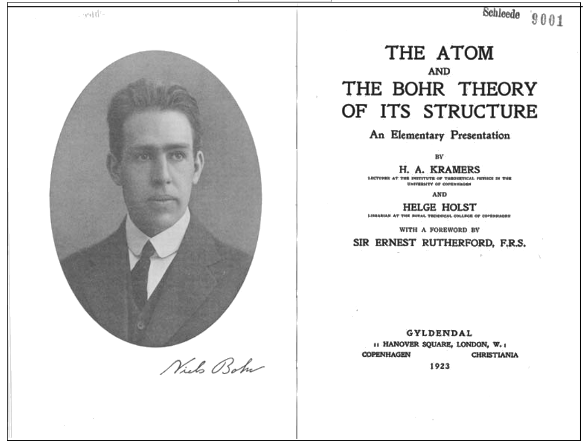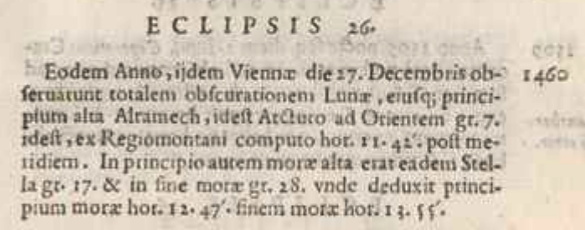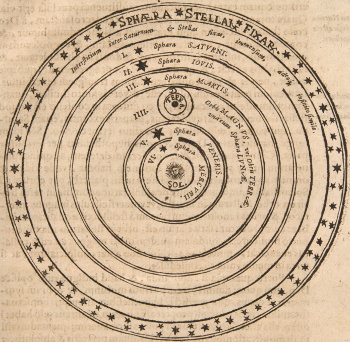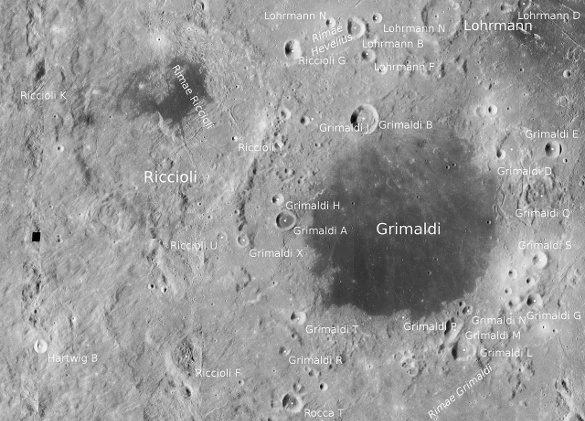Giovanni Battista Riccioli
December 2, 2019
They say that "
history is written by the victors," and this is true for the
history of science. While the successful
theories are presented in
textbooks, their opposing theories are lost in the
mists of time. The names of the winners, such as
Copernicus and
Einstein, become
household words. These
scientists become topics of
hagiographies, while the proponents of the opposition theories are either forgotten or
vilified.
I wrote about one example of this in an
earlier article (Bohr Model of the Atom, January 3, 2012) in which I summarized the
arXiv paper, "Spreading the gospel: The Bohr atom popularized," by
Helge Kragh and
Kristian Hvidtfelt Nielsen.[1] This arXiv paper recalls the several
models of the atom that appeared at the time of
Bohr's atomic theory, and it also explains how Bohr's theory was
popularized (see image).

Frontpiece of H. A. Kramers and H. Holst, 'The Atom and the Bohr Theory of its Structure,' (Gyldendal, London), 1923. This book, which helped to popularize Bohr's atomic model, was originally published in Danish in 1922, the same year that Bohr received the Nobel Prize in Physics.[1] It was subsequently translated and published in many languages, the English translation of which was done by a young Robert Bruce Lindsay (1900-1985) and his wife Rachel Tupper Lindsay.[1] Lindsay is known for his acoustics research, as well as his own physics popularizations. (Click for larger image.)
Chemists were most eager to develop an atomic theory, and
American chemist,
Gilbert N. Lewis (1875-1946), jumped into the fray with his 1902
cubic atom. This model had
electrons positioned at the eight
corners of a
cube, and this explained
atomic valency, since the
elements in the first three rows of the
periodic table have eight electrons (two
s-electrons and six
p-electrons) in their
outer shell. Of course, the
transition metals were hard to explain, and two
decades later,
quantum mechanics came along to explain the periodic table in detail. I wrote about Lewis in a
previous article (Gilbert N. Lewis, November 16, 2011).
Although Bohr prevailed, his 1913 atomic theory was on shaky ground at the start. It was just another contender and was only victorious a
decade later after sufficient development of quantum mechanics. The principal problem with the Bohr planetary model was that its electrons are
accelerating charges, and accelerating charges
radiate energy. The electrons in
orbit about a
nucleus will lose energy and
spiral into the nucleus.
Quantum mechanics and the Bohr model would not have existed were it not for the
Scientific Revolution, which occurred many
centuries prior. While many
scientific disciplines flourished after the
Middle Ages, the greatest turning point in human thought was when
Nicolas Copernicus (1473-1543) launched the
Copernican Revolution that supplanted the
geocentric model of the universe with a
heliocentric model.
Isaac Newton, in his 1687
Philosophiæ Naturalis Principia Mathematica, derived
Kepler's laws of planetary motion from his
gravitation equations as well as other
phenomena that could only be explained by a heliocentric
Solar System. At that point, heliocentrism was proved, but there was quite a gap between the 1543 publication of Copernicus'
De revolutionibus orbium coelestium and Newton's Principia. In that period, heliocentrism was still questioned, and many of the best arguments against it were developed by
Italian astronomer and
Jesuit priest,
Giovanni Battista Riccioli (1598-1671). Although geocentrism was later proven wrong, Riccioli's astronomical observations and physical
experiments were significant, so it's unfortunate that he is not more widely known.
.jpg)
Giovanni Battista Riccioli (1598-1671) holding a copy of his major work, the 1651 Almagestum Novum (The New Almagest).
The original Almagest, written in Greek by the Claudius Ptolemy (c.100-c.170) in the 2nd century, was an influential exposition on astronomy that presented evidence for geocentrism.
The Almagest had a profound influence on astronomical thought through the time of Copernicus.
(Image by Johann Gabriel Doppelmayer (1677-1750), plate 3 from the 1742 edition of the Atlas Coelestis (Homann: Nuremberg), via Wikimedia Commons)
Riccioli was born in
Ferrara, Italy, in 1598, and he began studies in a Jesuit
seminary in 1614, eventually becoming a
Catholic priest in 1628. He was trained as a
theologian, but he taught
logic,
physics, and
metaphysics at the College of
Parma from 1629 to 1632, where he did experiments with
falling bodies and
pendulums. As a
student, Riccioli became interested in astronomy, and his interest was so deep that his Jesuit superiors decided that he should pursue astronomical research. To that end, he built a well equipped
observatory at the College of
Santa Lucia in
Bologna and joined the circle of astronomers of that period that included
Christiaan Huygens (1629-1695), who discovered
Saturn's moon,
Titan, and
Giovanni Cassini (1625-1712), who discovered four moons of Saturn and the
division in its rings that's named after him.
Like his contemporary, Christiaan Huygens, Riccioli studied pendulums as a means for precision
timekeeping, developing a pendulum with a period of one
second with about 99% accuracy. I wrote about Huygens' work with pendulums in a
previous article (Coupled Oscillators, November 15, 2011). Riccioli used a pendulum as a timepiece in falling body experiments from Bologna's
Torre de Asinelli, where he confirmed
Galileo's square-law observation.[3-4] He did notice that balls of different
materials did travel at slightly different rates, a phenomenon that he correctly attributed to
air resistance.[3] Riccioli's many experiments on falling bodies confirmed the validity of
gravitational acceleration.[4]
Riccioli's major work, the 1651
Almagestum Novum, consisted of ten books and a total of more than 1500
folio (38 cm x 25 cm) pages. It included detailed
maps of the
Moon, including one in which Riccioli named
lunar features. His names form the basis for the
lunar nomenclature of today in which craters were named after important astronomers. You can view Riccioli's lunar map at
Wikimedia Commons. The site of the
Apollo 11 Moon landing, the
fiftieth anniversary of which we observed this year, received its
Mare Tranquillitatis (Sea of Tranquility) name from Riccioli. Also tabulated were the motions of
planets,
comets, and
novae.

Description of a total lunar eclipse of December 17, 1460, from Book II, page 97, of Giovanni Riccioli's Almagestum novum. (Image from a PDF file of the book available from the ETH-Bibliothek Zürich rare book collection.)[2]
Several hundred of pages of Riccioli's 1651 Almagestum Novum concerns whether the
Solar System is
geocentric or
heliocentric and considers such topics as whether the
Earth rotates or is immobile. In Book IX of his Almagestum Novum, Riccioli presents 126 arguments about the motion of the Earth.
Religion played just a small role in these arguments, since Riccioli stressed careful,
reproducible experiments.[5] While it was conceded that the strict
Ptolomaic model was dead, there was still the geocentric possibility that the planets circled the
Sun while the
stars, Moon, and Sun (with its planets, perhaps with the exception of
Jupiter and
Saturn) circled an immobile Earth.
One argument against a rotating Earth was the observed absence of what is known today as the
Coriolis effect.[5] Riccioli reasoned that were the Earth to rotate, a
canon ball shot northward would veer to the
east, since the Earth moves at different speeds at different
latitudes.[6] However, he also claimed that there would be no deflection were the cannon ball fired to the east. In actuality, the
Coriolis force would still
angle the shot to the right. In any case, the effect is so small that its observation in Riccioli's time was not possible. Riccioli was wise enough to realize that
birds in the
sky would not be left behind by a rotating Earth, since they might share the same eastward movement.
Another major argument that Riccioli presents against the Copernican theory is
stellar size. Because of
optical deficiencies,
stars viewed through
telescopes of his time all appeared as
disks, rather than
points of
light. This disk appearance, known today as an
Airy disk, is a result of the
diffraction of light, but astronomers of the time thought that these disks were real.

The heliocentric system from the 1596 Mysterium Cosmographicum of Johannes Kepler.
This ordering of the cosmos has an outermost sphere labeled, "sphaera stellar fixar," or sphere of fixed stars.
(Wikimedia Commons image from the University of Oklahoma History of Science Collections. Click for larger image.)
The Copernican theory presumed that the
fixed stars were at a very large distance from Earth, since they showed no
annual parallax. Riccioli and his Jesuit
colleague,
Francesco Grimaldi (1618-1663), made accurate measurements of stellar disk size and calculated what their physical sizes would be is they showed no parallax at the
limits of measurement.[7] The sizes, of course, were huge; and, not knowing about Airy diffraction, this fact would cause concern for a proponent of the Copernican theory.

Lunar craters Riccioli and Grimaldi, named after Giovanni Battista Riccioli (1598-1671) and his colleague, Francesco Maria Grimaldi (1618-1663), who assisted with the stellar size measurements. The Riccioli crater is 146 km in diameter, and it has coordinates 3.0°S 74.3°W. The Grimaldi crater is 173.49 km in diameter, and it has coordinates 5.2°S 68.6°W (NASA Lunar Reconnaissance Orbiter image, via Wikimedia Commons. Click for larger image.)
References:
- Helge Kragh and Kristian Hvidtfelt Nielsen, "Spreading the gospel: The Bohr atom popularised," arXiv, December 12, 2011.
- Giovanni Riccioli, "Almagestum novum," ETH-Bibliothek Zürich, Shelf Mark: Rar 9471, http://dx.doi.org/10.3931/e-rara-520. A PDF file of Book is available here.
- Christopher M. Graney, "Beyond Galileo: A translation of Giovanni Battista Riccioli's experiments regarding falling bodies and "air drag", as reported in his 1651 Almagestum Novum," arXiv, May 21, 2012.
- Christopher M. Graney, "Anatomy of a fall: Giovanni Battista Riccioli and the story of g," Physics Today, vol. 65, no. 9 (September, 2012), pp. 36-40, doi: 10.1063/PT.3.1716.
- Christopher M. Graney, "126 Arguments Concerning the Motion of the Earth, as presented by Giovanni Battista Riccioli in his 1651 Almagestum Novum," arXiv, March 14, 2011.
- Christopher M. Graney, "The Coriolis Effect Apparently Described in Giovanni Battista Riccioli's Arguments Against the Motion of the Earth: An English Rendition of Almagestum Novum Part II, Book 9, Section 4, Chapter 21, Pages 425, 426-7," arXiv, December 16, 2010.
- Christopher M. Graney, "Not the Earth, but its orbit: Andre Tacquet and the question of star sizes in a heliocentric universe, arXiv, September 26, 2019.
Linked Keywords: History is written by the victors; history of science; theory; theories; textbook; mists of time; Copernicus; Einstein; household word; scientist; hagiography; hagiographies; defamation; vilify; arXiv; scientific literature; paper; Helge Kragh; Kristian Hvidtfelt Nielsen; atomic theory; models of the atom; Bohr model; Bohr's atomic theory; popular science; popularize; book frontispiece; Frontpiece; Hans Kramers; H. A. Kramers; book; publication; publish; Danish language; Niels Bohr; Nobel Prize in Physics; translation; translate; language; English language; Robert Bruce Lindsay (1900-1985); wife; acoustics; research; physics; chemist; United States; American; Gilbert N. Lewis (1875-1946); cubical atom; cubic atom; electron; vertex (geometry); corner; cube; valence (chemistry); atomic valency; chemical element; periodic table; s-electron; p-electron; outer shell; transition metal; decade; quantum mechanics; acceleration; accelerating; electromagnetic radiation; radiate; energy; orbit; atomic nucleus; spiral; Scientific Revolution; century; branches of science; scientific discipline; Middle Ages; Nicolas Copernicus (1473-1543); Copernican Revolution; Ptolemaic system; geocentric model of the universe; heliocentrism; heliocentric model; Isaac Newton; Philosophiae Naturalis Principia Mathematica; Kepler's laws of planetary motion; Newton's law of universal gravitation; gravitation equations; phenomenon; phenomena; Solar System; De revolutionibus orbium coelestium; Italy; Italian; astronomer; Society of Jesus; Jesuit priest; Giovanni Battista Riccioli (1598-1671); experiment; Almagestum Novum; Almagest; Greek language; Claudius Ptolemy (c.100-c.170); 2nd century; geocentric model; geocentrism; Nicolaus Copernicus; Johann Gabriel Doppelmayer (1677-1750); Atlas Coelestis; Wikimedia Commons; Ferrara, Italy; seminary; Catholic priest; theology; theologian; logic; physics; metaphysics; Parma; equations for a falling body; falling bodies; pendulum; student; observatory; Saint Lucy; Santa Lucia; Bologna; Christiaan Huygens (1629-1695); Moons of Saturn; Titan (moon); Giovanni Cassini (1625-1712); Cassini Division; timekeeping devices; timekeeping; second; Two Towers, Bologna; Torre de Asinelli; Galileo's Leaning Tower of Pisa experiment; Galileo's square-law observation; material; drag (physics); air resistance; gravitational acceleration; Almagestum Novum; folio; map; Moon; lunar feature; selenography; lunar nomenclature; Apollo 11 Moon landing; fiftieth anniversary; Mare Tranquillitatis; planet; comet; nova; total lunar eclipse; ETH-Bibliothek Zürich rare book collection; Solar System; Earth; Earth's rotation; religion; reproducible experiments; Ptolomaic model; Sun; star; Jupiter; Saturn; Coriolis force; Coriolis effect; round shot; canon ball; projectile; northward; east; latitude; angle; bird; sky; stellar size; optics; optical; telescope; disk (mathematics); point (geometry); light; Airy disk; diffraction of light; Mysterium Cosmographicum; Johannes Kepler; cosmos; celestial sphere; fixed stars; University of Oklahoma; History of Science Collections; stellar parallax; colleague; Francesco Grimaldi (1618-1663); observational error; limits of measurement; impact crater; Riccioli (crater); Grimaldi (crater); NASA; Lunar Reconnaissance Orbiter.